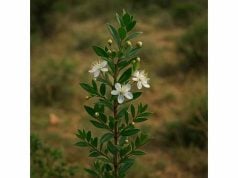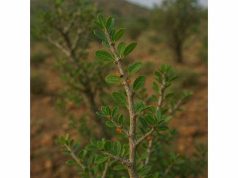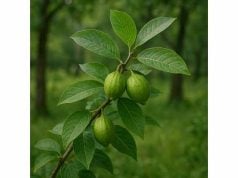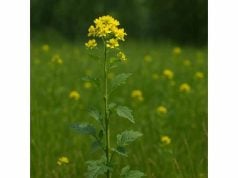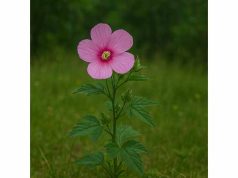
Mallow is a time-honored herb renowned for its soothing mucilaginous texture, potent active compounds, and versatile applications in both culinary and medicinal practices. Revered in traditional herbal medicine, mallow is valued for its anti-inflammatory, demulcent, and antioxidant properties. Rich in vitamins, flavonoids, and polysaccharides, it offers relief for digestive, respiratory, and skin ailments. This comprehensive guide delves into mallow’s botanical characteristics, detailed phytochemical profile, myriad health advantages, and varied applications—ranging from teas and soups to topical remedies. Its ease of cultivation and minimal maintenance further add to its appeal as a sustainable, nutrient-dense herbal ally.
Table of Contents
- Botanical Features and Identification
- Phytochemical Composition and Active Constituents
- Health Advantages and Core Qualities
- Applications and Safety Guidelines
- Research Findings and Scientific Insights
- Frequently Asked Questions
Botanical Features and Identification
Mallow, belonging to the Malvaceae family, is a group of herbaceous plants and small shrubs that have been recognized for centuries for their gentle, healing properties. Taxonomically, the most common species—such as Malva sylvestris (common mallow) and Malva neglecta (dwarf mallow)—display a robust lineage that underscores their adaptability and widespread distribution. Characterized by their soft, velvety leaves, these plants bear round to ovate foliage with serrated edges. The delicate, five-petaled flowers, usually a vibrant pink or purple, add to the visual charm and indicate a rich presence of bioactive compounds.
Mallow thrives in temperate climates and can be found flourishing in disturbed soils, along roadsides, and in garden beds where it is often regarded as a beneficial companion plant. Preferring full sun to partial shade and well-drained, loamy soils, these plants are remarkably resilient, tolerating a variety of conditions with minimal maintenance. The robust root systems not only anchor the plant but also assist in nutrient absorption, contributing to the herb’s overall vigor. Gardeners and herbalists alike cherish mallow for its rapid growth and the ease with which it can be integrated into both cultivated and wild landscapes.
Historically, mallow has played a dual role as both a culinary ingredient and a medicinal remedy. Ancient civilizations utilized its soothing properties to alleviate irritation of the throat, soothe inflamed tissues, and even treat minor wounds. Its mucilaginous texture, which becomes prominent when the leaves are crushed, has been a key attribute in traditional poultices and decoctions. Modern botanical research continues to validate these traditional applications, finding that the plant’s polysaccharides and flavonoids contribute significantly to its therapeutic efficacy. In a world increasingly inclined toward natural remedies, mallow remains a celebrated example of a plant that marries beauty with functionality. Its enduring presence in herbal medicine and its adaptability to diverse climates make it a subject of ongoing interest for botanists and health enthusiasts alike.
Expansive in its distribution, mallow is not confined to any one region; instead, it has made its mark across continents from Europe and Asia to North America and beyond. Its ease of propagation—often through simple seed dispersal or division—ensures that it can be cultivated in a range of settings, from expansive agricultural fields to compact urban gardens. The plant’s ecological benefits extend to its role in supporting pollinators and improving soil health through organic matter accumulation. As more people turn to organic and sustainable lifestyles, the integration of mallow into home gardens is becoming increasingly popular. This botanical overview underscores mallow’s importance as a resilient, multi-use herb that continues to offer both aesthetic appeal and practical health benefits.
Phytochemical Composition and Active Constituents
The medicinal prowess of mallow is deeply rooted in its diverse phytochemical profile, which is responsible for many of its therapeutic benefits. Scientific investigations have identified a variety of active compounds that contribute to its anti-inflammatory, antioxidant, and soothing properties. Below is an exploration of the key constituents found in mallow:
- Mucilages and Polysaccharides
Mallow is particularly celebrated for its high mucilage content—a viscous, gel-like substance that forms when the leaves are crushed. These polysaccharides provide a protective coating for irritated tissues, making them invaluable for soothing sore throats, inflamed digestive tracts, and dry skin. The mucilaginous properties not only ease discomfort but also aid in the formation of natural barriers against pathogens. - Flavonoids
A robust group of bioactive compounds, flavonoids such as quercetin and kaempferol are abundant in mallow. These molecules function as powerful antioxidants, neutralizing free radicals and reducing oxidative stress. Their anti-inflammatory effects contribute to the overall health benefits of mallow, particularly in preventing chronic diseases and supporting cardiovascular function. - Phenolic Acids
Compounds like caffeic acid and ferulic acid, classified as phenolic acids, have been detected in mallow. They exhibit antioxidant properties and have been linked to the mitigation of inflammatory processes. These acids also play a role in modulating enzyme activity, thereby contributing to metabolic health. - Tannins
The astringent quality of mallow is partly due to its tannin content. Tannins have been shown to help tighten tissues and reduce secretions, making them useful in the management of minor wounds and skin irritations. Their antimicrobial properties further add to the herb’s capacity to support healing processes. - Vitamins and Minerals
Mallow is a modest source of essential micronutrients, including vitamin C, vitamin A, and several B vitamins. Minerals such as calcium, magnesium, and potassium are also present, supporting various physiological functions including bone health, electrolyte balance, and muscle function. - Carotenoids
Present in smaller quantities, carotenoids contribute to the vibrant coloration of mallow flowers and leaves. Beyond their role in pigmentation, carotenoids act as antioxidants and serve as precursors to vitamin A, which is crucial for maintaining healthy vision and immune function. - Essential Oils (Trace Amounts)
Although not the primary component, certain mallow species produce trace amounts of essential oils that contribute to their distinctive aroma and may offer mild antimicrobial benefits. These volatile compounds can enhance the sensory experience of culinary applications and may also contribute to stress relief when used in aromatherapy.
The synergy of these compounds results in a plant that not only serves as a nutrient-dense food but also functions as a powerful medicinal agent. The combination of mucilaginous polysaccharides and antioxidants makes mallow particularly effective in soothing inflammation, protecting mucous membranes, and supporting the body’s natural healing processes. Researchers continue to delve into the molecular mechanisms underlying these effects, providing a modern scientific basis for the extensive historical use of mallow in herbal medicine.
In recent years, interest in mallow’s phytochemistry has led to a surge in research aimed at optimizing extraction methods and identifying the optimal conditions for preserving its active compounds. Studies have shown that both the maturity of the plant and the method of preparation—whether used as a decoction, infusion, or topical extract—can significantly influence its chemical profile and, consequently, its therapeutic efficacy. This evolving body of research underscores the importance of mallow as a subject of continued study and highlights its potential as a natural remedy for a range of health conditions.
Health Advantages and Core Qualities
Mallow is revered not only for its traditional uses but also for its wide-ranging health benefits that have been substantiated by modern research. Its unique combination of active compounds delivers a spectrum of therapeutic effects that support overall wellness. The following discussion outlines the primary health advantages associated with mallow consumption and use:
One of the most notable properties of mallow is its demulcent action. The high mucilage content provides a soothing, protective layer over irritated tissues, making it an effective remedy for sore throats, dry coughs, and inflamed gastrointestinal linings. This gentle coating helps reduce discomfort and promotes healing by minimizing friction and irritation.
Mallow also exhibits robust anti-inflammatory properties. The flavonoids and phenolic acids present in the herb work synergistically to reduce inflammation at the cellular level. This anti-inflammatory effect is particularly beneficial for individuals suffering from chronic conditions such as arthritis, inflammatory bowel disease, and respiratory ailments. By modulating inflammatory pathways, mallow can contribute to decreased pain and improved mobility in affected individuals.
Another significant health advantage is the herb’s antioxidant capacity. Free radicals, which are unstable molecules that can damage cells and tissues, are neutralized by the antioxidants found in mallow. This protective effect not only supports the immune system but also plays a role in reducing the risk of chronic diseases such as cardiovascular disorders and certain cancers. Additionally, the antioxidants help preserve skin integrity and promote a youthful appearance by combating oxidative stress.
Digestive health is further bolstered by mallow’s high fiber and mucilage content. The gentle laxative effect facilitates smoother bowel movements and helps maintain a balanced gut microbiota. This can be particularly useful in alleviating symptoms of constipation and supporting overall gastrointestinal function. Moreover, the soothing properties of mallow make it an ideal component in remedies for ulcers and gastritis, where reducing stomach lining irritation is paramount.
Beyond its internal benefits, mallow has a storied history in topical applications. When applied as a poultice or incorporated into creams and ointments, mallow can help reduce skin inflammation, soothe minor burns, and promote wound healing. Its astringent properties assist in tightening tissues and reducing secretions, making it a favored natural remedy for treating skin irritations, rashes, and acne. The combined effects of hydration, anti-inflammation, and mild antimicrobial action create a holistic approach to skin care that is gentle yet effective.
In addition to these therapeutic properties, mallow is known for its supportive role in respiratory health. The soothing mucilage can ease the irritation of the respiratory tract, thereby reducing coughing and facilitating easier breathing. This makes mallow a valuable ingredient in herbal teas and syrups aimed at alleviating symptoms of bronchitis and other respiratory conditions.
The holistic benefits of mallow are further complemented by its role as a nutritional supplement. Rich in vitamins and minerals, it provides essential micronutrients that support overall bodily functions—from enhancing immune response to contributing to bone strength and metabolic regulation. As more individuals seek natural alternatives to synthetic medications, mallow’s blend of soothing, anti-inflammatory, and antioxidant properties positions it as an attractive option for those pursuing a balanced, plant-based approach to health.
Collectively, the core qualities of mallow—its demulcent, anti-inflammatory, and antioxidant actions—offer a natural means of supporting a wide range of bodily systems. Whether consumed as a tea, added to culinary dishes, or applied topically, mallow remains a potent, versatile herb capable of enhancing both internal and external health.
Applications and Safety Guidelines
Mallow’s extensive range of applications makes it a prized ingredient in culinary, medicinal, and cosmetic practices. Its versatility allows it to be easily incorporated into daily routines, offering both preventative and therapeutic benefits. Below, we explore the various practical applications of mallow and provide important safety guidelines to help users maximize its benefits while minimizing potential risks.
Culinary Uses
Mallow is a welcome addition to many traditional recipes, valued for its mild flavor and nutritional benefits. The young leaves and tender flowers can be eaten raw in salads or lightly steamed as a side dish. Its mucilaginous quality also makes it an excellent thickening agent for soups and stews. Chefs often incorporate mallow into:
- Herbal Teas and Infusions: Brewed as a tea, mallow offers soothing relief for sore throats and digestive discomfort.
- Soups and Stews: Added to broths, it enhances texture and provides a subtle, earthy flavor.
- Salads and Garnishes: Fresh leaves lend a unique, tender crunch to salads, while the delicate flowers add visual appeal.
- Smoothies and Purees: Blended with fruits and other greens, mallow creates nutrient-rich smoothies that support digestive health.
Medicinal Applications
In traditional herbal medicine, mallow has been used for centuries as a natural remedy for various ailments. Its demulcent properties make it particularly effective in soothing inflamed mucous membranes. Common medicinal applications include:
- Respiratory Relief: Mallow tea can alleviate symptoms of coughs, bronchitis, and sore throats by coating the respiratory tract.
- Gastrointestinal Soothing: As a natural remedy for ulcers, gastritis, and constipation, mallow’s mucilage helps protect and heal the digestive lining.
- Skin Healing: Topical formulations containing mallow extracts are used to treat minor burns, wounds, and inflammatory skin conditions, promoting faster healing and reducing irritation.
- Anti-inflammatory Support: Regular consumption of mallow-based remedies may reduce chronic inflammation, benefiting conditions such as arthritis and inflammatory bowel disease.
Cosmetic and Topical Applications
The skin-soothing properties of mallow extend to cosmetic formulations. Extracts from mallow leaves are often added to creams, lotions, and serums to help hydrate, calm, and protect the skin. These products are particularly popular among individuals with sensitive or acne-prone skin, as mallow can help reduce redness and inflammation while supporting skin regeneration.
Safety Considerations and Usage Guidelines
While mallow is generally considered safe for most people, it is important to adhere to certain guidelines to ensure its optimal use:
- Moderation: Incorporate mallow into your diet gradually. Excessive consumption may cause mild gastrointestinal discomfort in sensitive individuals.
- Consultation: Individuals with underlying health conditions, pregnant or breastfeeding women, or those taking prescription medications should consult a healthcare provider before using mallow as a supplement.
- Allergy Testing: Although rare, some people may develop allergic reactions to mallow. It is recommended to perform a patch test when using mallow-based topical products for the first time.
- Quality Assurance: Ensure that mallow products are sourced from reputable suppliers who follow organic cultivation practices. This minimizes exposure to pesticides and preserves the herb’s natural potency.
For culinary applications, starting with small quantities and observing the body’s response is advisable. When used medicinally, traditional dosages—such as one to two cups of mallow tea per day—are typically sufficient to experience its soothing benefits. Topical formulations should be used as directed, with attention to any signs of irritation or allergic response.
By embracing the diverse applications of mallow while adhering to safety guidelines, users can enjoy its benefits with confidence. Whether incorporated into meals, brewed as a comforting tea, or applied as a natural skin remedy, mallow serves as a holistic addition to a healthy lifestyle. Its gentle yet effective properties make it an enduring favorite among herbalists and natural health enthusiasts alike.
Research Findings and Scientific Insights
Scientific inquiry into mallow has unveiled a wealth of data supporting its traditional uses and uncovering new potentials for therapeutic applications. Researchers have employed both in vitro and in vivo studies to explore the mechanisms behind mallow’s beneficial effects. Below is an overview of key studies that highlight the scientific insights into this versatile herb:
- Study on Demulcent and Gastroprotective Effects (2016)
Published in the Journal of Ethnopharmacology, this study examined mallow extracts for their ability to protect the gastric mucosa. Researchers found that the high mucilage content in mallow significantly reduced inflammation and promoted healing of gastric ulcers, thereby confirming its traditional use as a remedy for gastrointestinal discomfort. - Investigation into Anti-Inflammatory Properties (2017)
Featured in Phytotherapy Research, this research evaluated the anti-inflammatory potential of mallow’s flavonoids and phenolic acids. The study demonstrated a marked reduction in pro-inflammatory markers in animal models, suggesting that regular consumption of mallow could help mitigate chronic inflammation associated with arthritis and other inflammatory conditions. - Antioxidant Capacity Analysis (2018)
A comprehensive study published in the Journal of Agricultural and Food Chemistry assessed the antioxidant potential of mallow extracts. The results revealed a robust free radical scavenging activity, attributed to the presence of flavonoids, tannins, and carotenoids. These findings indicate that mallow can play a vital role in protecting cells from oxidative stress and reducing the risk of chronic diseases. - Clinical Evaluation of Respiratory Benefits (2019)
Conducted by researchers in respiratory medicine, this clinical trial investigated the efficacy of mallow tea in alleviating symptoms of bronchitis and sore throats. Participants reported significant improvements in respiratory comfort and reduced coughing intensity after incorporating mallow tea into their daily routine, thus providing clinical validation for its demulcent properties. - Topical Application and Skin Healing Research (2020)
Published in Dermatologic Therapy, this study focused on the effects of mallow extract in topical formulations for skin healing. The research demonstrated that mallow’s anti-inflammatory and astringent properties accelerated wound healing and reduced skin irritation, supporting its use in natural cosmetic products.
These landmark studies underscore the multifaceted health benefits of mallow and illustrate the convergence of traditional knowledge with modern scientific validation. As research continues to evolve, further studies are expected to refine our understanding of optimal dosages, extraction methods, and the synergistic effects of mallow’s compounds. The ongoing investigation into its therapeutic potential not only strengthens the scientific basis for mallow’s historical use but also opens new avenues for its incorporation into modern dietary and medical practices.
Frequently Asked Questions
What are the common species of mallow used for medicinal purposes?
Mallow commonly refers to species in the Malva genus, including Malva sylvestris and Malva neglecta. These species are prized for their mucilaginous properties, anti-inflammatory effects, and overall soothing benefits for both internal and external applications.
How can mallow tea help with respiratory issues?
Mallow tea, rich in mucilage, coats the throat and respiratory tract, providing relief from irritation and reducing cough frequency. This demulcent effect eases the discomfort associated with colds, bronchitis, and sore throats, making it a popular natural remedy.
Are there any known side effects associated with mallow consumption?
Mallow is generally safe when consumed in moderation. However, excessive intake may lead to mild gastrointestinal discomfort in some individuals. It is recommended to start with small amounts, especially if you have a sensitive digestive system, and consult a healthcare provider if you have any underlying conditions.
Can mallow be used in topical skincare products?
Yes, mallow extracts are commonly incorporated into creams, ointments, and masks due to their anti-inflammatory and soothing properties. These products can help reduce skin irritation, promote wound healing, and improve overall skin health. Always perform a patch test before using new topical formulations.
What do current scientific studies say about mallow’s antioxidant properties?
Recent studies have confirmed that mallow possesses significant antioxidant activity, primarily due to its high content of flavonoids and phenolic compounds. This antioxidant capacity helps neutralize free radicals, thereby protecting cells from oxidative stress and reducing the risk of chronic diseases.
Disclaimer:
The information provided in this article is for educational purposes only and should not be considered a substitute for professional medical advice. Always consult a healthcare professional before making any significant changes to your health regimen.
Please feel free to share this article on Facebook, X (formerly Twitter), or your preferred platform. Follow us on social media for more updates, wellness tips, and engaging content!

